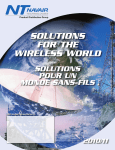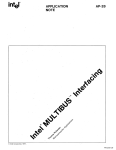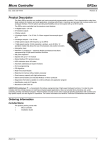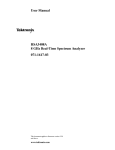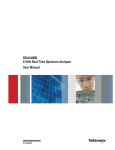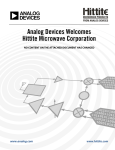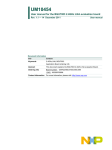Download ADRF Duo-i6525 User manual
Transcript
Duo-i6525 USER MANUAL Version 1.0 2607 Colorado Blvd. Los Angeles, CA 90041 USA Tel: 323-254-8131 Fax: 323-254-4928 www.adrftech.com Duo-i6525 RF Repeater User Manual V1.0 Glossary The following is a list of abbreviations and terms used throughout this document. Abbreviation/Term AGC ALC AROMS BTS CDMA CFE CW DAS DL Downlink HPA HW iDEN IF LNA MS PLL PS RF SQE SW UL Uplink VSWR Definition Automatic Gain Control Automatic Level Control ADRF’ Repeater Operation and Management System Base Transceiver Station Code Division Multiple Access Compact Front End Continuous Wave (un-modulated signal) Distributed Antenna System Downlink The path covered from the Base Transceiver Station (BTS) to the subscribers service area via the repeater High Power Amplifier Hardware Integrated Digital Enhanced Network Intermediate Frequency Low Noise Amplifier Mobile Station Phased Locked Loop Power Supply Radio Frequency Signal Quality Estimate Software Uplink The path covered from the subscribers service area to the Base Transceiver Station(BTS) via the repeater Voltage Standing Wave Ratio Advanced RF Technologies, Inc. Proprietary Document Page 2 of 31 Duo-i6525 RF Repeater User Manual V1.0 Version 1.0 (Released January 08, 2007) Information in this document is subject to change without notice. Advanced RF Technologies, Inc. 1996-2007. All rights reserved. Please send comments to: E-Mail: [email protected] Phone: (323) 254-8131 Fax: (323) 254-4928 Address: Advanced RF Technologies, Inc. Attention: Technical Publications Department 2607 Colorado Blvd., 1st Floor Los Angeles, CA 90041 USA www.adrftech.com Advanced RF Technologies, Inc. Proprietary Document Page 3 of 31 Duo-i6525 RF Repeater User Manual V1.0 TABLE OF CONTENTS 1. Duo-i6525 .........................................................................................................5 1.1. Introduction.....................................................................................................5 1.1.1. Highlights ......................................................................................5 1.1.2. Parts List ........................................................................................5 1.1.3. Repeater Quick View.......................................................................7 1.2. Warnings and Hazards........................................................................................8 2. Duo-i6525 Overview ..........................................................................................9 2.1. Block Diagram .................................................................................................9 2.2. Operation Modes ............................................................................................10 2.2.1. Local Web GUI ..............................................................................10 2.2.2. Remote NMS (Modem Option) .......................................................10 2.3. Components ..................................................................................................10 2.3.1. 2.3.1 Power Supply.......................................................................10 2.3.2. Controller.....................................................................................10 2.3.3. Down Converter Module ...............................................................10 2.3.4. Up Converter Module....................................................................10 2.3.5. Quad-Plexer.................................................................................11 2.3.6. Digital Filter .................................................................................11 2.4. Switches & Indicators ......................................................................................12 2.4.1. LEDs.............................................................................................12 2.4.2. Power Switch ................................................................................13 2.4.3. Mode Selection Switch ..................................................................13 2.5. Installation ....................................................................................................14 2.5.1. Tools............................................................................................14 2.5.2. Procedure.....................................................................................14 2.5.3. Grounding ....................................................................................16 3. 4. 2.5.4. Antenna Separation/Isolation........................................................17 Duo-i6525 AROMS Setup .................................................................................19 Maintenance Guide for Duo-i6525....................................................................26 4.1. Periodic Inspection Checklist .............................................................................26 4.2. Preventive Measures for Optimal Operation ...........................................................26 4.2.1. Recommendations ........................................................................26 5. 4.2.2. Precautions ..................................................................................27 Warranty and Repair Policy ...............................................................................27 5.1. General Warranty ............................................................................................27 5.2. Limitations of Warranty ....................................................................................27 5.3. Limitation of Damages .....................................................................................27 5.4. No Consequential Damages ...............................................................................27 5.5. Additional Limitation on Warranty ......................................................................27 5.6. Return Material Authorization (RMA) ..................................................................28 Appendix A: Specifications ................................................................................................29 Advanced RF Technologies, Inc. Proprietary Document Page 4 of 31 Duo-i6525 RF Repeater User Manual V1.0 1. Duo-i6525 1.1. Introduction Duo-i6525 is a dual band SMR (800 and 900 MHz) RF repeater which enhances in-building wireless coverage in the most effective and cost efficient way. For its intelligent design and versatility, the Duo-i6525 is the ideal choice for wireless coverage problems indoors. Duo-i6525 can be used as a stand-alone repeater with passive antennas connected to it or it can also be used as a feeder repeater to a DAS (Distributed Antenna System). 1.1.1. Highlights • Dual Band Repeater (800 & 900 MHz) • 25 dBm Composite Output Power • 65 dB gain • 25 dB AGC Range @ 0.5 dB Step • Digital Filtering • Excellent out of band rejection characteristics with Sharp Roll-Offs @ 65 dBc • Re-Banding Capability via Digital Filtering • Band Adjustable Option @ 200 KHz step • Web GUI Software via DHCP • Oscillation Detection Scheme 1.1.2. Parts List Label A B C D E F Qty 1 1 1 1 4 1 Description iDEN Repeater AC Power Cable Ground Cable Ethernet Cable (Twisted) guard screws CD Table 1 – Parts List Advanced RF Technologies, Inc. Proprietary Document Page 5 of 31 Duo-i6525 RF Repeater User Manual V1.0 Figure 1 – Duo-i6525 Repeater Parts List ** CD includes: (1) Duo-i6525 User Manual & (2) Duo-i6525 Quick Start Guide Advanced RF Technologies, Inc. Proprietary Document Page 6 of 31 Duo-i6525 RF Repeater User Manual V1.0 1.1.3. Repeater Quick View Power LED (Page 12) Soft Fail LED (Page 12) Upper Guard Screw (Page 14) Hard Fail LED (Page 12) Bracket Screw (Page NMS Modem (Page 10) Lower Guard Screw (Page 14) Ground Hole (Page 16) Donor Antenna Port (Page 17) Power Switch (Page 13) Guard screw Hole (Page 14) Ethernet Port (Page 19) Server Antenna Port (Page 17) Mode Selection Switch (Page 13) Wall Mounting Bracket (Page 14) Advanced RF Technologies, Inc. Proprietary Document Page 7 of 31 Duo-i6525 RF Repeater User Manual V1.0 1.2. Warnings and Hazards WARNING! ELECTRIC SHOCK Opening the Duo-i6525 could result in electric shock and may cause severe injury. WARNING! EXPOSURE TO RF Working with the repeater while in operation, may expose the technician to RF electromagnetic fields that exceed FCC rules for human exposure. Visit the FCC website at www.fcc.gov/oet/rfsafety to learn more about the effects of exposure to RF electromagnetic fields. WARNING! DAMAGE TO REPEATER Operating the Duo-i6525 with antennas in very close proximity facing each other could lead to severe damage to the repeater. RF EXPOSURE & ANTENNA PLACEMENT Guidelines Actual separation distance is determined upon gain of antenna used. Please maintain a minimum safe distance of at least 20 cm while operating near the donor and the server antennas. Also, the donor antenna needs to be mounted outdoors on a permanent structure. Advanced RF Technologies, Inc. Proprietary Document Page 8 of 31 Duo-i6525 RF Repeater User Manual V1.0 WARRANTY Opening or tampering the Duo-i6525 will void all warranties. 2. Duo-i6525 Overview 2.1. Block Diagram Figure 2 – Duo-i6525 Repeater Block Diagram Advanced RF Technologies, Inc. Proprietary Document Page 9 of 31 Duo-i6525 RF Repeater User Manual V1.0 2.2. Operation Modes 2.2.1. Local Web GUI Simply connect one end of the ethernet cable on the repeater monitor port and the other end on the PC’s LAN port. After doing so, launch the Microsoft Internet Browser (Internet Explorer) and the Local Web GUI will be launched through typing the IP address (http://192.168.63.1/home.asp) 2.2.2. Remote NMS (Modem Option) A CDMA wireless modem can be integrated within a Duo-i6525 repeater. With this wireless modem, the user can remotely log into the repeater for monitoring purposes. 2.3. Components 2.3.1. 2.3.1 Power Supply It provides DC power to each module within the repeater. 2.3.2. Controller It is responsible for monitoring the status of each module and controls its parameters. If a CDMA wireless modem is integrated within the repeater, it also handles the remote “Command & Control” feature as well. 2.3.3. Down Converter Module The downlink RF signal entered through the cavity filter is converted to IF frequency, which is later converted back to RF frequency again through digital filtering. The downlink HPA (high power amplifier) is integrated with the Down Converter Module. 2.3.4. Up Converter Module The uplink RF signal entered through the cavity filter is converted to IF frequency, which is later converted back to RF frequency again through digital filtering. The uplink HPA (high power amplifier) is integrated with the Up Converter Module. Advanced RF Technologies, Inc. Proprietary Document Page 10 of 31 Duo-i6525 RF Repeater User Manual V1.0 Noise Filter DHCP Sub Board Quad-Plexer Quad-Plexer Down Converter Up Converter Controller Interface Board Digital Filter Digital Filter Power Supply Figure 3 – Duo-i6525 Repeater Internal Components Diagram 2.3.5. Quad-Plexer It consists of four BPFs (band-pass filters) each of the four RF signal paths: SMR 800 (Tx & Rx) and SMR 900 (Tx & Rx) 2.3.6. Digital Filter It is composed of A/D (analog to digital) and D/A (digital to analog) converters. It also has a FPGA (field programmable gate array) which has the capability for superior out-of- band rejection and re-banding. Advanced RF Technologies, Inc. Proprietary Document Page 11 of 31 Duo-i6525 RF Repeater User Manual V1.0 2.4. Switches & Indicators 2.4.1. LEDs Duo-i6525 has three LEDs on the top panel of the repeater as show below in Figure 4. Figure 4 – Duo-i6525 Repeater LED View POWER If the LED is lit GREEN, it indicates that there is AC power to the repeater. SOFT FAIL If the LED is lit YELLOW, it indicates that there is a soft fail alarm in the system. The detailed alarm information can be viewed via the local web GUI. In the event of a soft fail alarm, the repeater will still function, but the alarm needs to be addressed promptly. HARD FAIL If the LED is lit RED, it indicates that there is a hard fail alarm in the system. The detailed alarm information can be viewed via the local web GUI. In the event of a hard fail alarm, the repeater will not function and immediate attention is required. Advanced RF Technologies, Inc. Proprietary Document Page 12 of 31 Duo-i6525 RF Repeater User Manual V1.0 2.4.2. Power Switch The AC Power on/off switch is located on the bottom of repeater. The switch should be powered on after the repeater has been installed properly. Figure 5 – Duo-i6525 Repeater Power Switch View 2.4.3. Mode Selection Switch The Ethernet port and the mode selection switch for DHCP are located on bottom of the repeater as shown below in Figure 5. The mode selection switch has two modes: Host Mode & Remote Mode. Figure 6 – DHCP & Mode Selection Switch View Advanced RF Technologies, Inc. Proprietary Document Page 13 of 31 Duo-i6525 RF Repeater User Manual V1.0 Host Mode This mode should be selected only if a Duo-i6525 is used alone without being connected to a collocated Sprint Nextel CDMA repeater functioning as a host. Remote Mode This mode should be selected if a Sprint Nextel CDMA repeater is being installed along with aDuo-i6525 and the ethernet port is being used for communicating with the CDMA repeater. In this case, a Duo-i6525 works as a remote sending its information to the collocated Host CDMA repeater. 2.5. Installation 2.5.1. Tools No special tools or equipments are needed in installing the Duo-i6525. 2.5.2. Procedure Four mounting holes are provided on the wall-mounting bracket to attach it to the wall. The wall bracket must be securely attached to sufficiently carry the weight of the Duo-i6525, which is bolted to the wall bracket through four aligned mounting holes. The following steps should be followed while mounting the repeater: Installation Procedure ① Take the Duo-i6525 out of the box ② Detach the mounting bracket from the Duo-i6525 by unscrewing the 8 screws on the bracket. ( 4 on each side) ③ Using the four guard screws, mount the bracket on the wall ④ Make sure the bracket is securely mounted ⑤ Slightly tilt the repeater and mount the repeater onto the wall as shown in the picture. Hook the upper 2 guard screws first and then slide/push in the lower 2 guard screws into the place. ⑥ Make sure the repeater is securely placed onto the wall bracket ⑦ Fasten the 8 bracket screws back properly ⑧ Inspect everything is secure Advanced RF Technologies, Inc. Proprietary Document Page 14 of 31 Duo-i6525 RF Repeater User Manual V1.0 Figure 7 – Repeater Mounting Instructions Advanced RF Technologies, Inc. Proprietary Document Page 15 of 31 Duo-i6525 RF Repeater User Manual V1.0 2.5.3. Grounding The Duo-i6525 has locks on the side of the enclosure preventing from the door opening. In addition, a ground cable is also included in the box and should be connected to repeater. Figure 8 – Ground Cable Connection Advanced RF Technologies, Inc. Proprietary Document Page 16 of 31 Duo-i6525 RF Repeater User Manual V1.0 2.5.4. Antenna Separation/Isolation Separation between antennas is necessary to prevent oscillation. Oscillation occurs when the signal entering the system continually reenters, due to the lack of separation between the donor and server antennas. In other words, the signal is being fed back into the system. This creates a constant amplification of the same signal. As a result, the noise level rises above the signal level. Figure 9 - RF Repeater Oscillation To prevent feedback, the donor and server antennas must be separated by an appropriate distance to provide sufficient isolation. Isolation is attained by separating antennas a sufficient distance so that the output of one antenna does not reach the input of the other. This distance is dependent on the gain of the repeater. A sufficient isolation value is 13 ~ 15 dB greater than the maximum gain of the repeater. For example, if the gain of the repeater is 50 dB, then an isolation of 63 ~ 65 dB or greater is required. In the same manner, because the Duo-i6525 has a maximum gain of 65 dB, it requires an isolation of at least 78 ~ 80 dB. Advanced RF Technologies, Inc. Proprietary Document Page 17 of 31 Duo-i6525 RF Repeater User Manual V1.0 2.5.5 Line of Sight The donor antenna which points towards the base station typically has a narrow beam antenna pattern. As a result, a slight deviation away from the direction of the BTS can lead to less than optimum results. In addition, obstacles between the repeater and the BTS may impair the repeater from obtaining any BTS signal. As a result, the repeater cannot transmit signal to the coverage area. Therefore, a direct line of sight to the BTS for the donor antenna is vital to the function of a repeater. For the same reason, placing the server antenna in direct line of sight of the coverage area is also necessary. BTS Donor Antenna Figure 10 - Direct Line of Sight to the BTS Advanced RF Technologies, Inc. Proprietary Document Page 18 of 31 Duo-i6525 RF Repeater User Manual V1.0 3. Duo-i6525 AROMS Setup i) Connect the LAN cable between laptop’s Ethernet port and repeater’ Ethernet port. Note: Under Local Area Connection in Network Settings, make sure to select Obtain an IP address automatically under Internet Protocol (TCP/IP) properties. Advanced RF Technologies, Inc. Proprietary Document Page 19 of 31 Duo-i6525 RF Repeater User Manual V1.0 ii) Launch MS Internet Explorer (Version 6.0 or higher) Note: ADRF’s Web GUI is not compatible with any other web browsers (e.g. Netscape, FireFox, Mozilla, etc.). iii) Please type the following IP address on the address bar of MS Internet Explorer: http://192.168.63.1/home.asp iv) The following login screen will appear: If you are not the Super-User, please type in your assigned username & password which you should have received from the Super-User. The default username and password for the General User is adrf & adrf, respectively. If the username & password is typed in incorrectly, the following screen will appear: Advanced RF Technologies, Inc. Proprietary Document Page 20 of 31 Duo-i6525 RF Repeater User Manual V1.0 v) If you click on Status tab, the following window will appear: In this window, the user can view the following: To change any parameters, e.g., iDEN Band, Gain Settings, you have to go to Install or Control Menu. - iDEN Band: Will display the center frequencies of the 800 and 900 MHz spectrums on the downlink and uplink respectively. - Power & Gain: Will display the repeater input, gain and output power on the downlink and uplink. Advanced RF Technologies, Inc. Proprietary Document Page 21 of 31 Duo-i6525 RF Repeater User Manual V1.0 - Alarm: Will display five alarms with three different status conditions (Normal, Soft Fail or Hard Fail). Message Board: Will show up to recent 20 log messages (Alarms & Heartbeats). Modem: Will display the status of the mode (e.g. Disabled, Not Connected or Connected) Installation: Will display repeater’s installation status (Not Installed or Installed). Repeater Info: Will display repeater’s serial number, modem ESN and MDN. Repeater Location: Will display the address where the repeater is installed Technical Support: Will display ADRF’s Technical Support contact information. Installer Contact Info: Will display the installer’s name, phone and e-mail address. Note: Once successfully logged in, the repeater model name and the site/cascade ID will be displayed on the top of all the windows (except for the Main Window). Parameters DL/UL Output Power DL Input Power Gain Range -10 ~ 28 dBm Step Size 0.1 dB 5 ~ -95 dBm 40 ~ 65 dB 0.1 dB 0.5 dB Table 2 – Default Parameter Ranges vi) If you click on Control tab, the following window will appear: In this window, the user can adjust the following parameters: General Setting - Automatic Gain Control (Default mode is Off) Advanced RF Technologies, Inc. Proprietary Document Page 22 of 31 Duo-i6525 RF Repeater User Manual V1.0 - Downlink HPA on/off (Default mode is On) - Uplink HPA on/off (Default mode is On) - Uplink Tracking mode on/off (Default mode is Off) Manual Gain Control - Downlink Gain Control (40 to 65 dB @ 0.5 dB step, default value: 25 dB) - Uplink Gain Control (40 to 65 dB @ 0.5 dB step, default value: 25 dB) - Downlink AGC Level (15 to 25 dBm @ 0.5 dB step) - Uplink AGC Level (15 to 25 dBm @ 0.5 dB step) - Uplink Tracking Offset (0 to 10 dB @ 0.5 dB step - Default mode is Off) System - If you click the Reboot button, the following message box will appear: - If you click the Factory Setting button, the following message box will appear: Heartbeat Time - Heartbeat on and off (Default mode is Off) - Heartbeat periodic time (Range: 1 to 59 min @ 1 min step – Default time is 20 min) Alarm Setting - RSSI Alarm at Donor (-95 ~ -50 dBm @ 0.5 dB step – Default value is -75 dBm) - RF Power Alarm (2 ~ 10 dB @ 0.5 dB step – Default value is 3 dB) vii) If you click on Install tab, the following window will appear: Advanced RF Technologies, Inc. Proprietary Document Page 23 of 31 Duo-i6525 RF Repeater User Manual V1.0 - Band Selection: Simply click on the desired operating bandwidth. - Modem: By default, auto-connection box is checked so that the modem will connect automatically once sufficient donor signal is present. - SNMP: Type in the assigned site/cascade ID and manager IP address. Default Site ID and Manager IP address is ADRF and 100.10.10.100 respectively. - Repeater: Click Install button to automatically setup the repeater. - Repeater Location: Will display the physical address where the repeater is installed - Repeater Installer Info: Will display the installer’s name, phone and e-mail Address for technical support. viii) If you click on System tab, the following window will appear: Note: If you are the Super User, you will see account management section under the System Window. If you are a local user, you will not be able to see the account management portion. Advanced RF Technologies, Inc. Proprietary Document Page 24 of 31 Duo-i6525 RF Repeater User Manual V1.0 Only the Super-User can add, delete and modify a user. The following window illustrates how a new user can be added by simply clicking on New Account. The following window illustrates how a new administrator can be added by simply clicking on Administrator. Advanced RF Technologies, Inc. Proprietary Document Page 25 of 31 Duo-i6525 RF Repeater User Manual V1.0 If you click on Firmware Upgrade, the following window will appear. You can browse through your PC and locate the firmware file. Once it’s selected, simply click on Update and it’ll upload the latest firmware automatically and close the session. You will need to re-login again. 4. Maintenance Guide for Duo-i6525 4.1. Periodic Inspection Checklist a. Check for loose connections to the repeater and antennas. If connections are loose, make sure that all connections are tightly fastened properly. Cables and connectors are in good condition. Ensure that the repeater brackets are in good condition and that the repeater is securely fastened. b. c. 4.2. Preventive Measures for Optimal Operation 4.2.1. Recommendations • Perform the Periodic Inspection Checklist quarterly or semiannually. Advanced RF Technologies, Inc. Proprietary Document Page 26 of 31 Duo-i6525 RF Repeater User Manual V1.0 4.2.2. Precautions • Do not operate the repeater with the antennas in extremely close proximity as this may cause damage to the repeater. • Do not change parameters unless instructed to do so by an authorized supervisor. • Do not move the repeater unless instructed to do so by an authorized supervisor. • Do not detach any cables to the repeater unless repair of respective components are necessary. 5. Warranty and Repair Policy 5.1. General Warranty The Duo-i6525 carries a Standard Warranty period of five (5) years unless indicated otherwise on the package or in the acknowledgment of the purchase order. 5.2. Limitations of Warranty Your exclusive remedy for any defective product is limited to the repair or replacement of the defective product. Advanced RF Technologies, Inc. may elect which remedy or combination of remedies to provide in its sole discretion. Advanced RF Technologies, Inc. shall have a reasonable time after determining that a defective product exists to repair or replace the problem unit. Advanced RF Technologies, Inc. warranty applies to repaired or replaced products for the balance of the applicable period of the original warranty or ninety days from the date of shipment of a repaired or replaced product, whichever is longer. 5.3. Limitation of Damages The liability for any defective product shall in no event exceed the purchase price for the defective product. 5.4. No Consequential Damages Advanced RF Technologies, Inc. has no liability for general, consequential, incidental or special damages. 5.5. Additional Limitation on Warranty Advanced RF Technologies, Inc. Proprietary Document Page 27 of 31 Duo-i6525 RF Repeater User Manual V1.0 Advanced RF Technologies, Inc. standard warranty does not cover products which have been received improperly packaged, altered, or physically damaged. For example, broken warranty seal, labels exhibiting tampering, physically abused enclosure, broken pins on connectors, any modifications made without Advanced RF Technologies, Inc. authorization, will void all warranty. 5.6. Return Material Authorization (RMA) No product may be returned directly to Advanced RF Technologies, Inc. without first getting an approval from Advanced RF Technologies, Inc. If it is determined that the product may be defective, you will be given an RMA number and instructions in how to return the product. An unauthorized return, i.e., one for which an RMA number has not been issued, will be returned to you at your expense. Authorized returns are to be shipped to the address on the RMA in an approved shipping container. You will be given our courier information. It is suggested that the original box and packaging materials should be kept if an occasion arises where a defective product needs to be shipped back to Advanced RF Technologies, Inc. To request an RMA, please call (323) 254-8131 or send an email to [email protected]. Advanced RF Technologies, Inc. Proprietary Document Page 28 of 31 Duo-i6525 RF Repeater User Manual V1.0 Appendix A: Specifications (1) Electrical Specifications Parameters Specifications SMR800 DL Frequency SMR800 UL 851 ~ 869 MHz or 862 ~ 869 MHz 806 ~ 824 MHz or 817 ~ 824 MHz SMR900 DL 935 ~ 940 MHz SMR900 UL 896 ~ 901 MHz Composite DL +25 dBm Output Power UL +25 dBm Gain Ripple DL / UL ≤ ±1.25 dB p-p Maximum 65 dB Range 0 ~ 25 dB Step 0.5 dB Tolerance ±0.5 dB Roll Offs DL / UL ≥ 65 dBc 900 MHz DL Gain (DL / UL) Inter-modulation Adjustable Band Edge 2nd harmonic SMR800 DL SMR900 DL ≤ -105 dBm Adjust: 868.8 MHz, 868.6 MHz Default: 940 MHz (SQE Degradation) 25 dB ALC ≤ 20% OIP3 DL / UL ≥ 43 dBm VSWR DL / UL ≤ 1.5: 1 Spurious RF Emission DL / UL ≤ -13 dBm Noise Figure UL ≤ 8 dB @max gain Delay DL / UL ≤ 8 us - @ 0.5 MHz outside passband At 1870 ~ 1880 MHz @ 200 kHz steps Adjust: 939.8 MHz, 939.6 MHz ≤ 10% Impedance 800 + 900 MHz Default: 869 MHz 15 dB ALC ALC Range Remark @ Gain 65 dB/40 dB 50 Ohms Advanced RF Technologies, Inc. Proprietary Document Page 29 of 31 Duo-i6525 RF Repeater User Manual V1.0 (2) Mechanical Specifications Parameters Specifications Remark Dimension 14.13 x 18.92 x 7.59 inch 359 x 480.5 x 192.5 mm Weight < 44 lbs RF Ports N-type (F) Local Interface RJ45 (DHCP) Cooling Air Convection IP Class IP 20 Mounting Type Wall Mounting Donor & Server Antenna Ports Indoor Type 19” Rack Mounting Option Available (3) Environmental Specifications Parameters Specifications Remark Operating Temperature -10 ~ +50 ℃ Ambient Relative Humidity 5 ~ 95 %, non-condensing Dust Industrial dust per Telcordia GR63 core (4) Power Specifications Parameters Specifications AC Power 110 ~ 125 AC AC Frequency 45 ~ 65 Hz AC Supply Protection Fuse DC Power Option -40 ~ -60 V or +20 ~ 30 V Power Consumption ≤ 140 W Ground External Threaded Stud Remark (5) Environmental Specifications Parameters Specifications MTBF > 100,000 Hours Certificates UL 60950, FCC Part 90 Warranty 5 Years Advanced RF Technologies, Inc. Proprietary Document Remark Page 30 of 31 Duo-i6525 RF Repeater User Manual V1.0 (6) Mechanical Drawings Advanced RF Technologies, Inc. Proprietary Document Page 31 of 31































